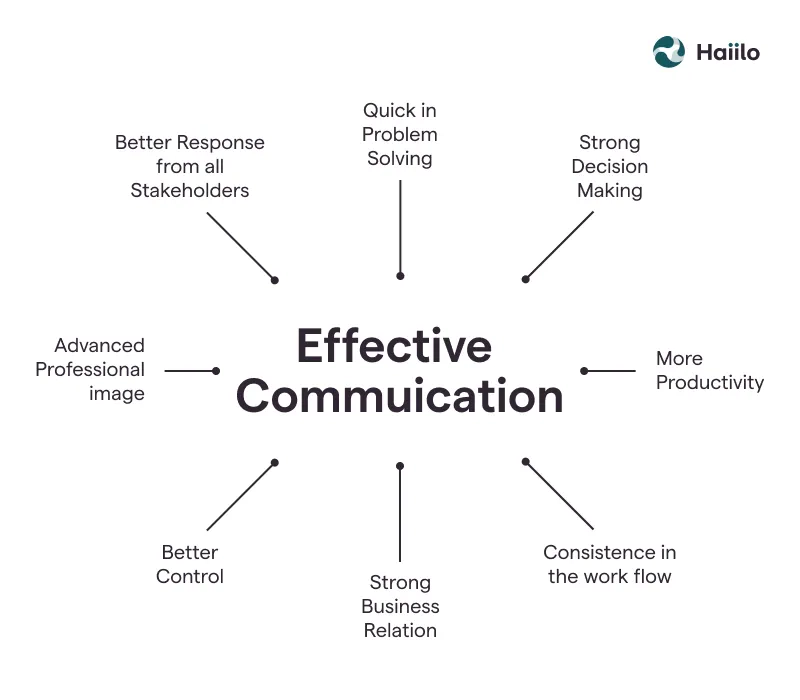Welcome to our comprehensive guide on improving communication in the workplace! In today’s fast-paced world, effective communication skills are crucial for building strong teams, fostering collaboration, and ensuring successful business outcomes.
Whether you’re a seasoned professional or are just starting your career, these 36 tips will empower you to improve communication at work and navigate workplace dynamics with finesse. Let’s dive in!
Verbal Communication Skills Tips
Effective verbal communication sets the foundation for clear and meaningful interactions with your colleagues. Here are some tips to enhance your skills:
- Use clear and concise language: Avoid using jargon or unnecessary complexity when communicating. Be mindful of your audience and convey your message in a way that is easily understandable.
2. Practice active listening skills: When engaging in conversations, give your undivided attention to the speaker. Active listening is one of the best ways to improve your communication skills. Show that you are actively listening by nodding, maintaining eye contact, and responding appropriately.
3. Avoid interrupting or talking over others: Respect others’ opinions and avoid interrupting them mid-sentence. Wait for an appropriate pause before speaking and create space for everyone’s voice to be heard.
- Give and receive constructive feedback: Feedback is crucial for growth. Provide feedback in a constructive and respectful manner, focusing on specific actions. Similarly, be open to receiving feedback and use it as an opportunity to improve.

Tips to Improve Non-Verbal Communication in the Workplace
Non-verbal cues play a significant role in how our messages are interpreted. Paying attention to them can lead to better communication skills:
- Pay attention to body language: Notice both your own body language and that of others. Maintain an open posture, face the person you are speaking to, and avoid crossing your arms, which can give off defensive vibes.
Maintain appropriate eye contact: Eye contact demonstrates engagement and interest in the conversation. However, be mindful not to make others uncomfortable with prolonged or intense eye contact.
Use facial expressions to show understanding and empathy: Your facial expressions can convey empathy, agreement, or concern. Utilize them to support your verbal communication and make your message more impactful.
Use gestures to reinforce your message: Body movements and gestures can enhance your communication. Use them to emphasize key points or to showcase enthusiasm during presentations or discussions.
Communication is the master key to success in the workplace. Unleash your potential with these 36 game-changing tips! #EffectiveCommunication #WorkplaceWisdom #UnlockSuccess
Written Effective Communication Tips
The ability to communicate effectively in written form is essential in today’s digital workplace. Here are some tips to elevate your written communication skills:
- Use proper grammar, punctuation, and spelling: Proofread your emails and messages to ensure they are error-free. Simple mistakes can undermine your professionalism and credibility.
Adopt a professional tone in emails and messages: Maintain a polite and professional tone when communicating electronically. Avoid using emojis, slang, or overly informal language in business communication.
Organize information in a clear and logical manner: Structure your written communication, such as emails or reports, to make it easy for the reader to follow. Use paragraphs, headings, and bullet points to enhance readability.
Proofread and review before sending: Before hitting the send button, take a moment to review your message. Ensure it conveys your intended message and is free from any errors or misunderstandings.

Technology-related Workplace Communication Tips
In today’s digital age, technology plays a crucial role in effective communication in the workplace. Here are some tips for leveraging technology effectively:
- Utilize collaborative tools and platforms: Explore digital collaboration tools like Slack, Microsoft Teams, or Google Workspace to streamline communication and foster teamwork.
Be mindful of digital etiquette: Maintain professionalism even in virtual interactions. Avoid using all caps (which signifies yelling), use proper salutations, and respond promptly to messages.
Use appropriate channels for different types of communication: Choose the right communication medium for the message. Use email for more formal and lengthier discussions, while instant messaging is suitable for quick queries or updates.
Double-check recipients and subject lines before hitting send: Before sending an email, double-check that you have selected the correct recipients and have provided a clear and descriptive subject line to ensure your message is received and understood.
Effective Workplace Team Communication
Strong team communication is vital for collaboration and achieving shared goals. Consider these ways to improve communication within teams:
- Foster a culture of open communication: Encourage team members to share ideas, concerns, and feedback openly. Create an environment where everyone feels comfortable expressing their thoughts.
Encourage participation and active engagement: During team meetings, ensure all members have opportunities to contribute. Encourage active participation and make sure quieter team members feel included in the conversation.
Organize regular team meetings or huddles: Set aside time for regular team meetings or quick huddles to align on goals, share progress, and address any challenges. These gatherings foster collaboration and keep everyone informed.
Create opportunities for team-building activities: Engage in team-building activities that help build rapport among team members. This can range from virtual happy hours to community service initiatives outside of work.
Interdepartmental Communication Tips
Interdepartmental communication plays a crucial role in bridging gaps between teams and achieving organizational synergy:
- Encourage collaboration and knowledge sharing between departments: Foster a culture of cross-departmental collaboration and communication. Encourage teams to share knowledge, insights, and best practices to enhance overall performance.
Establish communication channels to bridge gaps between teams: Set up regular communication channels, such as shared project management platforms or cross-functional meetings, to ensure departments stay connected and informed.
3. Understand and respect different departments’ working styles and perspectives: Different departments may have unique ways of working. Acknowledge and respect these differences while finding methods to effectively collaborate and communicate despite them.
- Establish regular check-ins or cross-functional meetings: Schedule periodic check-ins or meetings between teams to discuss shared projects, address challenges, and align on objectives. These touchpoints help maintain productive interdepartmental communication.
Conflict Resolution Communication Strategies
Conflict can arise in any workplace, but effective workplace communication can help navigate difficult conversations and find resolutions:
- Practice active listening during conflict discussions: Give each party involved in the conflict an opportunity to express their perspective. Show respect, empathy, and understanding by actively listening without interrupting, and don’t be afraid to ask questions.
Encourage everyone to express their thoughts and concerns: Create a safe space for open communication where all parties feel comfortable expressing their thoughts and concerns with their own communication style. Encourage constructive dialogue and find common ground.
Find common ground and work towards a solution together: Focus on areas of agreement and common goals. Collaborate with all parties involved to find solutions that address the underlying issues and move toward resolution.
Promote empathy and understanding: Encourage individuals to put themselves in others’ shoes to better understand their perspectives. This helps foster empathy, which can lead to more effective conflict resolution.
Feedback and Performance Communication Tools
Feedback is a powerful tool for growth and improvement. Here are some tips for effective feedback and performance communication:
- Provide timely feedback to employees: Offer feedback in a timely manner, both for positive contributions and areas that require improvement. Prompt feedback helps individuals understand the impact of their actions, make necessary adjustments, and share their thoughts on the company.
Give praise and recognition when deserved: Acknowledge and appreciate employees’ achievements and efforts. Publicly recognizing their hard work fosters a positive work environment and motivates others.
Offer constructive criticism in a respectful manner: When providing constructive feedback, focus on specific behaviors or actions rather than attacking the individual. Frame your feedback as an opportunity for growth, highlighting areas for improvement.
Encourage self-assessment and continuous improvement: Encourage employees to reflect on their own performance and identify areas where they can improve. Provide support and resources to facilitate their professional growth.
Communication Training and Continuous Improvement Tips
Communication skills can always be enhanced. Here are some tips for ongoing improvement:
- Provide communication training opportunities for employees: Offer workshops, webinars, or training sessions to help employees develop effective communication skills. These resources can empower them to navigate workplace dynamics more effectively.
Encourage reading books or articles on effective communication: Promote self-learning by recommending books or articles on effective communication. Sharing valuable resources ignites curiosity and encourages continuous improvement.
Share resources and tools for improving communication skills: Provide employees with tools, such as templates or guides, that can help them enhance their communication skills. These resources can serve as valuable references in their daily interactions.
Regularly assess and evaluate communication processes and make necessary improvements: Continuously evaluate the effectiveness of your communication processes. Seek feedback from employees and make necessary adjustments to enhance overall communication within the workplace.
Why Should You Improve Communication within Your Workplace?
Improving communication within your workplace is essential for a thriving and successful business. Effective communication lays the foundation for a collaborative and engaged workforce. When employees can express their thoughts, concerns, and ideas openly and honestly, it fosters a positive work environment where everyone feels valued and heard. Increasing employee engagement.
Strong communication skills also help in avoiding misunderstandings and conflicts, saving time and resources. Transparent communication enhances teamwork and collaboration, allowing for better problem-solving and decision-making. Productivity increases when everyone is on the same page and can effectively communicate goals, expectations, and deadlines.
Additionally, improved communication leads to stronger customer relations, as employees are better equipped to understand and address the needs and desires of clients. By prioritizing communication within your workplace, you are investing in the growth and success of your business, empowering your employees, and cultivating a positive and productive work culture.

The Effects of Poor Communication in the Workplace
Effective communication is the backbone of any successful workplace. When communication breaks down, the entire team suffers. Poor communication can lead to a multitude of problems, ranging from misunderstandings to decreased productivity. It creates confusion, and frustration, and can even harm employee morale.
Without clear and open communication, tasks are more likely to be misinterpreted or forgotten, resulting in errors and delays. Additionally, poor communication can lead to a lack of trust and collaboration among team members, as people become hesitant to share their ideas or concerns. This can stifle creativity and innovation, hindering the team’s ability to problem-solve and make progress.
On the other hand, strong communication skills can foster a positive and productive work environment. When everyone is on the same page and information flows freely, ideas are shared, and conflicts are resolved more effectively. By prioritizing effective communication, organizations can create a culture of transparency, teamwork, and success.
Conclusion
Communicating effectively in the workplace is not only about conveying information but also about fostering understanding, collaboration, and positive relationships. By implementing these 36 crucial tips, you can improve your communication skills and create a more harmonious and successful work environment. Start applying them today and experience the positive impact they can have on your professional journey!
We hope you found this guide on improving workplace communication valuable. Remember, effective communication is a skill that requires practice, patience, and ongoing growth. With dedication and consistent effort, you can become a master of communication and excel in your professional endeavors.



